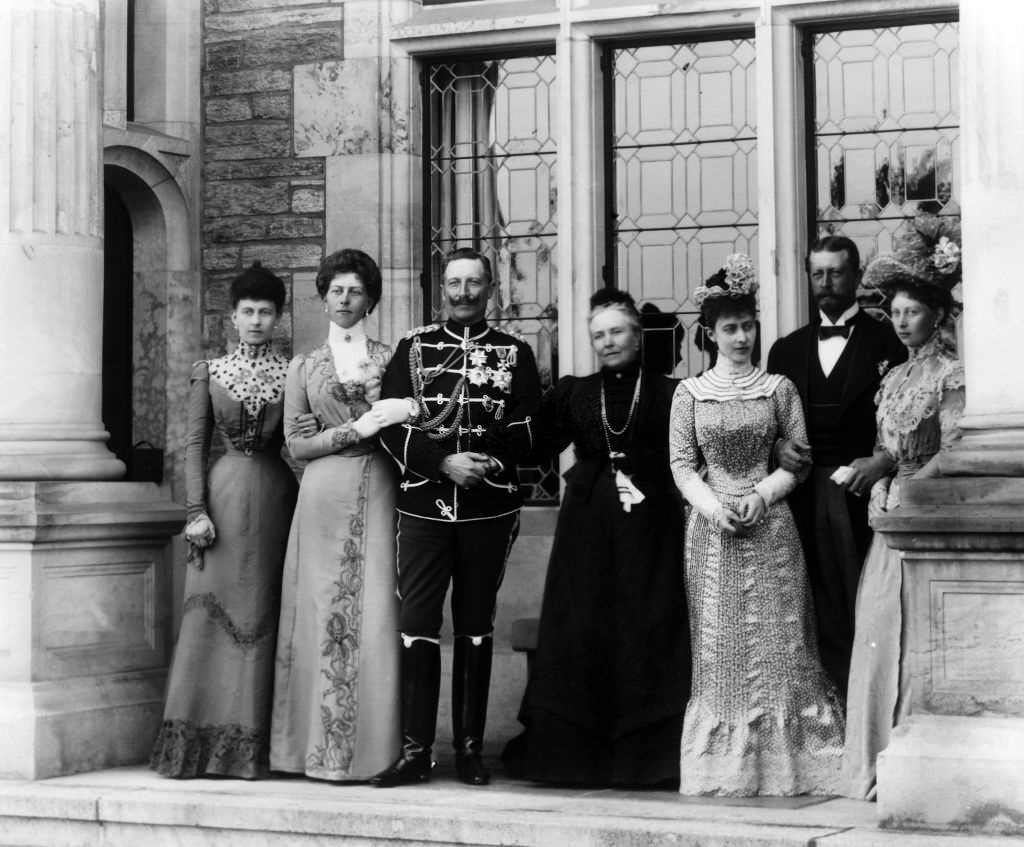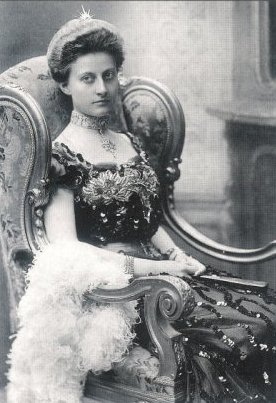by Susan Flantzer © Unofficial Royalty 2015

Charlotte of Prussia, Duchess of Saxe-Meiningen; Credit – Wikipedia
Princess Charlotte of Prussia (Viktoria Elisabeth Auguste Charlotte) was the second child and eldest daughter of Friedrich III, German Emperor and King of Prussia and his wife Victoria, Princess Royal, the eldest child of Queen Victoria of the United Kingdom. She was born at the Neues Palais in Potsdam, Kingdom of Prussia, now in Brandenburg, Germany, on July 24, 1860, and was christened Viktoria Elisabeth Auguste Charlotte. Charlotte’s mother considered her the most difficult of all her children. As a toddler, Charlotte started to bite her nails and pull at her clothes and was forced to wear gloves or stand with her hands tied together. Charlotte also seemed to have learning difficulties. Her governess and tutors told her mother they had never had such difficulties as with Charlotte. Charlotte was a favorite of her paternal grandparents whose spoiling did not help the situation.
Charlotte had seven siblings:
- Wilhelm II, German Emperor (1859 –1941) married (1) Princess Auguste Viktoria of Schleswig-Holstein, had issue (2) Princess Hermine Reuss of Greiz, no issue
- Heinrich (1862 –1929) married his first cousin Princess Irene of Hesse and by Rhine, had issue
- Sigismund (1864 – 1866) died of meningitis at 21 months
- Victoria (1866 – 1929) married (1) Prince Adolf of Schaumburg-Lippe, no issue (2) Alexander Zoubkov, no issue
- Waldemar (1868 – 1879) died of diphtheria at age 11
- Sophie (1870 – 1932) married King Constantine I of Greece, had issue
- Margarete (1872 –1954) married Prince Friedrich Karl of Hesse, had issue

Charlotte’s mother and siblings in 1900: Sophia, Victoria, Wilhelm, their mother Empress Frederick, Charlotte, Heinrich, and Margaret; Photo Credit – Wikipedia
Charlotte wanted to leave home as quickly as possible. As a marriage offered her the only way out, Charlotte found herself a prince, her shy and well-educated second cousin Bernhard, Hereditary Prince of Saxe-Meiningen. Because the prince was a suitable marriage candidate and their daughter caused much unrest at home, Charlotte’s parents agreed to the marriage. Charlotte and Bernhard were engaged in 1876 and married in Berlin, Kingdom of Prussia, now in the German state of Brandenburg, on February 18, 1878, when Charlotte was not quite 18.

Charlotte of Prussia with Bernhard of Saxe-Meiningen around the time of the engagement; Credit – Wikipedia
Charlotte and Bernhard had one child, the first great-grandchild of Queen Victoria:
- Princess Feodora of Saxe-Meiningen (1879 – 1945), married Prince Heinrich XXX Reuss, no children

Feodora circa 1900; Photo Credit – Wikipedia
After the birth of her only child, Charlotte neglected her daughter in favor of society life in Berlin which caused Feodora to be cared for by nannies and servants and her maternal grandmother. Feodora was a long-term houseguest at her grandmother’s home Friedrichshof. Her grandmother said of her, “She is really a good little child and far easier to manage than her Mama…The atmosphere of her home is not the best for a child her age.”
In 1891, Charlotte was involved in the Kotze Affair, a scandal in which several members of the aristocracy and members of the family of Wilhelm II, German Emperor were accused in anonymous letters of sexual debauchery.
In 1914, Charlotte’s husband became the last reigning Duke of Saxe-Meiningen. His reign was short as Bernhard was forced to abdicate on November 10, 1918, and spent the rest of his life in his former country as a private citizen.
Charlotte was a chain smoker and had suffered ill health her entire life. She died on October 1, 1919, at the age of 59, in Baden-Baden, Germany. She was buried at Schloss Altenstein, the summer residence of the Dukes of Saxe-Meiningen, now in Bad Liebenstein in the German state of Thuringia.

Burial site of Charlotte and her husband; Credit – Wikipedia
This article is the intellectual property of Unofficial Royalty and is NOT TO BE COPIED, EDITED, OR POSTED IN ANY FORM ON ANOTHER WEBSITE under any circumstances. It is permissible to use a link that directs to Unofficial Royalty.
Saxe-Meiningen Resources at Unofficial Royalty
